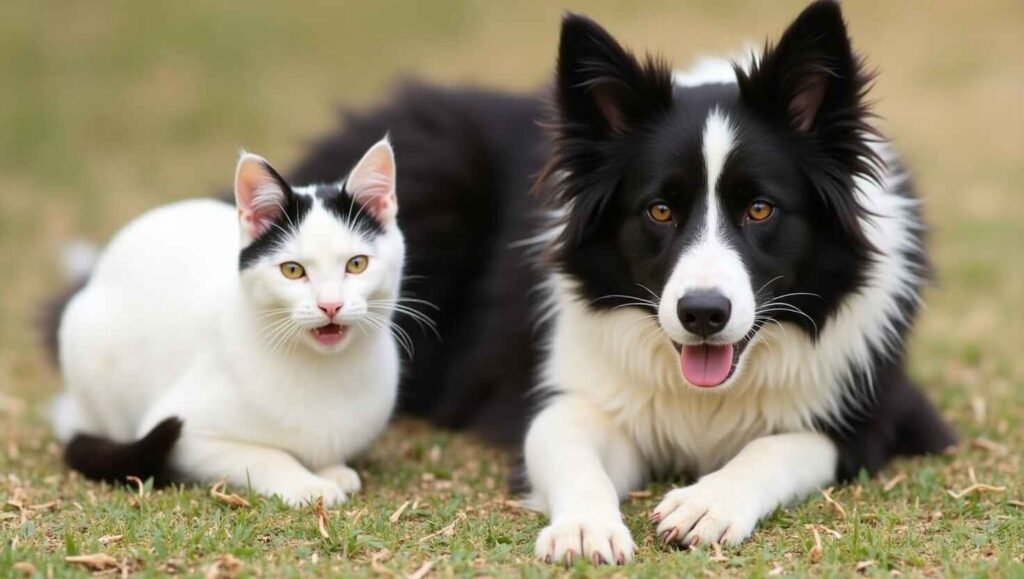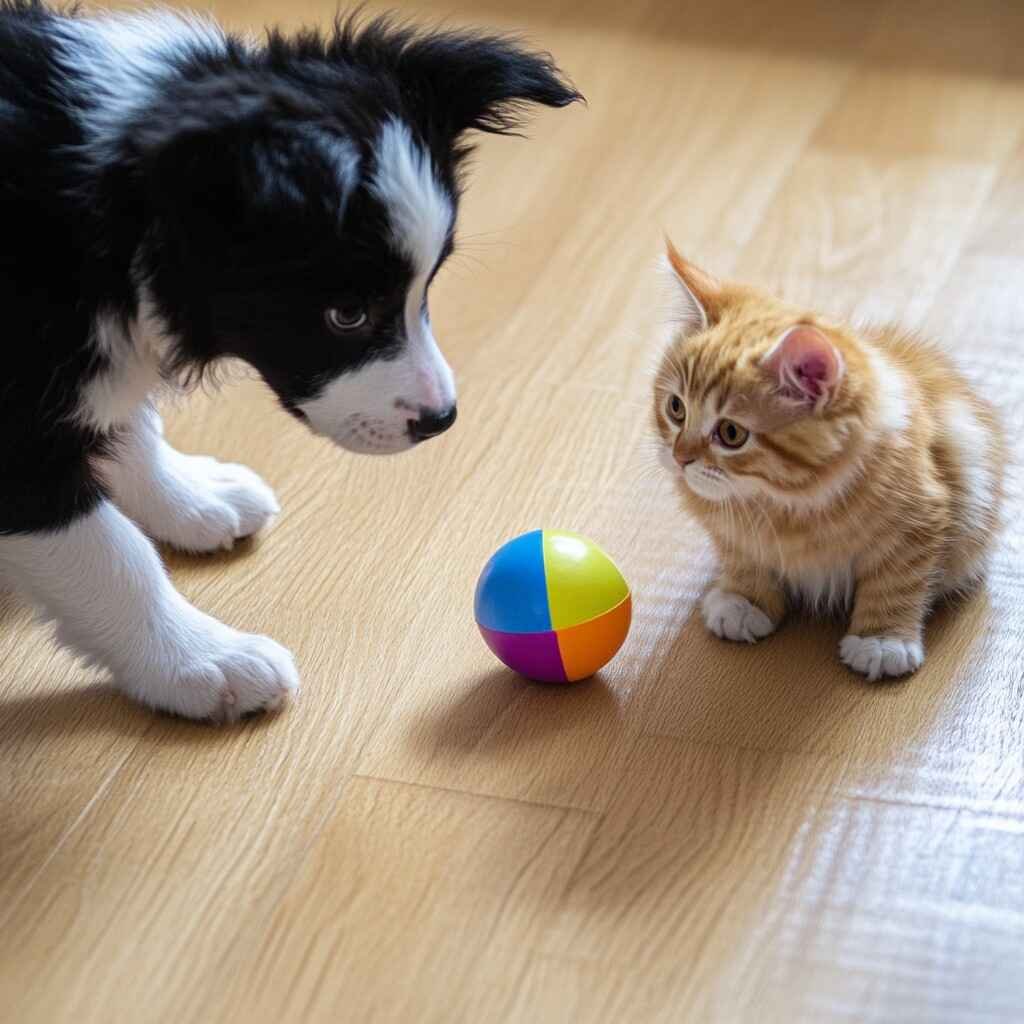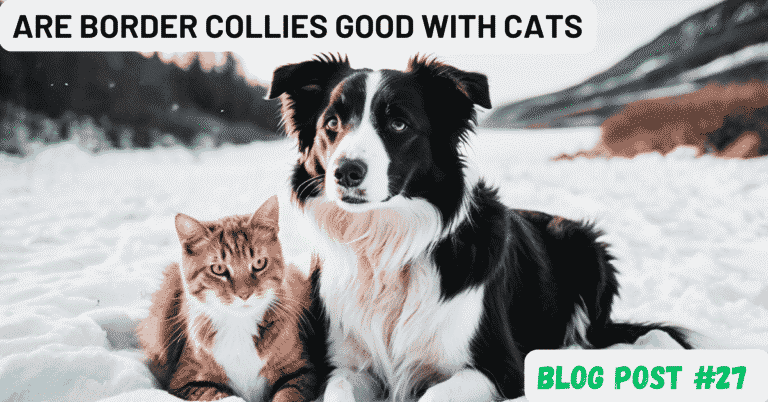By Tom, 10-Year Border Collie Owner & Trainer
Border Collies are famous for their intelligence and their herding instincts. But what if you already have a cat in the house and are considering getting a collie? You may ask Are Border Collies Good With Cats? Questions like ‘Are Border Collies friendly with cats?’ or ‘Can a Border Collie live with a cat?‘ are commonly asked.
Introducing a high-energy Border Collie to a cat can be a real challenge, but also completely doable with the right approach. I’ve raised two Border Collies over the last six years in a multi-pet household. While one adopted very quickly with our house cat, the other took weeks of careful introduction and training.
“Border Collies have a strong instinct to chase, but with proper training, most can coexist with cats.”
– Dr. Sarah Ellis, Feline Behaviorist, International Cat Care
Understanding the dog and cat’s behavior and providing appropriate training can lead to peaceful coexistence in a multi-pet household. In this article, I’ll break down what you need to know, from understanding your Border Collie’s instincts to step-by-step tips for peaceful coexistence, and try to ensure Border Collies and cats live together harmoniously and address concerns about aggression and compatibility.
Contents
- 1 Are Border Collies Good With Cats- Behavior and Characteristics
- 2 Can a Border Collie live with a cat?- Initial Introductions
- 2.1 Will Your Border Collie Get Along With Cats?
- 2.2 Are Border Collies naturally good with cats?
- 2.3 Can a Border Collie and a cat become friends?
- 2.4 How do I introduce a Border Collie to a cat?
- 2.5 Are Border Collies aggressive toward cats?
- 2.6 What signs show my Border Collie is stressed around cats?
- 3 Conclusion
Are Border Collies Good With Cats- Behavior and Characteristics
It is crucial to understand fundamental traits and characteristics in establishing a peaceful coexistence with cats. Despite possessing high intelligence, incredible agility, and being highly trainable, Border Collies show notable traits that influence their interactions with other animals.
A 2022 study in Animals journal found 68% of herding dogs successfully adapted to cats after structured training
Also, their herding instincts can sometimes be mistakenly directed towards small animals, including cats and children. The need for mental stimulation and physical exercise shall be met consistently, so that the chance of showing unwanted habits can be reduced in border collies.

While interacting with cats, there will be certain challenges. The most common challenge is always chasing cats, and another can be their natural tendency to herd. This unwanted chasing and herding can be perceived by the cat as aggression.
When I introduced my Border Collie, Luna, to our new kitten, the key was rewarding calm behavior with high-value treats, such as chicken. Without this step, she’d fixate for hours.
That is why monitoring these interactions closely becomes crucial in initial introductions. Also, collies can be overwhelming buddies for cats, who may prefer a calm partner in the house.
Awareness
Its not that cats and dogs always go for each other. Dogs which are introduced to cats in their puppy stage, or even street dogs, they hardly pay any attention to cats. And the same goes for cats too.
Cats are independent and of a curious nature; they exhibit a highly developed sense of independence and prefer to explore and manage the environment on their terms. But they can also become uneasy and stressed out with sudden changes in the environment.
When putting a dog and a cat together in a house or a barn, understand that these cues will greatly help in coexistence. Cats are sensitive to their boundaries. A dog chasing a cat for fun can lead to defensive behaviors like hissing or scratching.
To make positive associations, it’s helpful to designate each one to different areas. For example, cats should be given elevated spaces where observing can be done from a distance. In this way, with gradual exposure territorial disputes can be minimized.
Can a Border Collie live with a cat?- Initial Introductions
To avoid unexpected interactions between a border collie and a cat, a right and tested approach create a healthy environment stage for a positive relationship.
Always use a barrier for first meetings. I recommend the IRIS Pet Gate ($45 on Amazon) – it’s tall enough to prevent jumping but lets pets see each other safely.
For start, you can set up different spaces for each pet where they can retreat when they feel overwhelmed. Baby gates can section off areas of the house. This allows both pets to observe and smell each other without direct contact and can become accustomed to each other’s presence.
Ensure both the collie and cat have access to their toys, beds, and feeding bowls, making them secure. After initial observations, you will get valuable insights on how their relationship may evolve. Body language, curiosity, and sniffing play a great role in every pet interaction.

Wagging tail or relaxed demeanor from the border collie is a positive sign, whereas a stiff posture and intense staring is a negative sign from the cat. Keep initial interactions short and simple with a leash on both pets. Then gradually increase the duration, maybe they end up playing, who knows?
If everything is going right, then perhaps a treat or reward is great to boost the morale of both pets. Recognizing calm behaviour can help both pets to associate with each other’s with positive outcomes.
Other advanced methods can be establishing boundaries, consistent routines, and positive reinforcement strategies. Positive reinforcement is one of the most effective ways to build and encourage good behavior.
Will Your Border Collie Get Along With Cats?
| Temperament Trait | Good With Cats? | Solution Needed |
| High prey drive | ❌ No | Professional trainer |
| Low energy | ✅ Yes | Minimal training |
| Herding instinct | ⚠️ Maybe | Redirect to toys |
Clear boundaries are crucial to retreat, especially for cats. A separate space creates a secure spot where the cat can retreat and not be worried about being chased or disturbed. Training stop and leave commands are equally important to prevent unwanted behaviors towards the cat by the dog.
These commands, when properly enforced, will discourage the dog and make him realize that harassing and chasing the cat is not allowed in the house.
Reddit user u/CollieCatMom shared: ‘After 3 weeks of scent-swapping and feeding on opposite sides of a gate, my Collie now ignores the cat completely.
All these suggestions sound easy, but they are not. For that, a consistent positive routine is needed to instill good behaviors in both pets. Regular routines provide stability and predictability for pets. Make a time slot available for both pets separately, where the pet parent can spend time and training joyfully.
Long-Term Tips for Harmony
Vet-Recommended Advice:
Dr. Linda Case (MS Animal Science) advises: ‘Provide cat shelves at 3+ heights to ensure escape routes.
The ‘Outward Hound Puzzle Toy’ ($22) reduces obsessive behavior by 40% in high-energy Collies.

Are Border Collies naturally good with cats?
Not always. Both can react differently and aggressively most of the time. Training and socialization can help.
Can a Border Collie and a cat become friends?
Definitely yes. Early introductions make things pretty much easy with positive reinforcement.
How do I introduce a Border Collie to a cat?
Begin slowly. Use a baby gate or a crate to let them observe each other. Reward calm behavior.
Are Border Collies aggressive toward cats?
Not aggressive, but collies do want to run after the cat, showing a herding trait.
What signs show my Border Collie is stressed around cats?
Barking, staring, lunging. These signs can be indications of stress and anxiety.
Conclusion
Maintaining a healthy relationship between your border collie and your cat is entirely possible. Patience and proper training will come in handy. So, are border collies good with cats? The answer depends on both the personalities of the pets and how they’re introduced.
They can learn to coexist and thrive as well. Eventually, the success of the pet’s relationship comes down to understanding the natural behaviors, their energy. With right approach and environment one can create a home where the dog and the feline thrive together happily.

